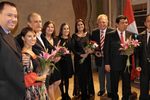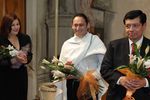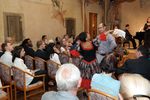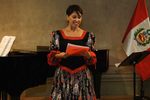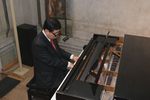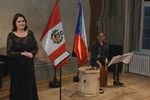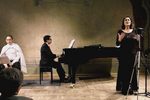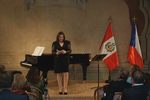Mixed Cultures Heritage in Peru’s Music

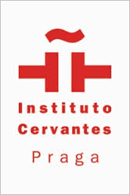

on the occasion of the 400th anniversary of the death of Garcilaso de la Vega, El Inca
Fátima Espinosa de Zavala – mezzosoprán
Manuel Sánchez – piano
Carlo Zegarra Abanto - perkuse
For audio-video extract from the concert please see Audio Video.
(Photo M.Setnička)
PROGRAM
Rosa Mercedes Ayarza de Morales (1881-1969):
1. La Rosa y el Clavel, mozamala (The Rose and the Carnation)
2. La Cambalachera, zamacueca (The Lady Swapper)
3. La Chichera, pregón/tondero (The Chicha Vendor)
4. La Picaronera, pregón (The Picarones Vendor)
5. India Bella, yaraví (arreglo de Rosa Mercedes) (An Indigen Beauty)
Carlos Valderrama Herrera (1887-1950):
6. La Pampa y la Puna, canción andina (The Prairie and the Plateau,Andean song)
Miguel Angel Hurtado Delgado (1922-1951):
7. Valicha, huayno cuzqueño
Daniel Alomía Robles (1871-1942):
8. El Cóndor Pasa (The Flight of the Condor)
Pedro Espinel Torres(1908-1981):
9. Sonrisas, polka (Smiles)
María Isabel Chabuca Granda (1890-1972):
10. Gallo Camarón, vals (Fighting Rooster)
Manuel Acosta Ojeda(1930-2015):
11. En un Atardecer, vals (At Twilight)
Chabuca Granda:
12. Puente de los Suspiros, vals ( Bridge of Sighs)
13. María Sueños, vals (Dreamy Maria)
Andrés Soto (1949):
14. El Tamalito, (The Little Tamale) pregón
Chabuca Granda:
15. El Surco, landó (The Furrow)
Eduard Ingriš (1905-1991):
16. Perú, Mi Amor *
R. M. Ayarza de Morales:
17. La Marinera
Notes for the PROGRAM:
Mozamala, zamacueca – ancient colonial dances that originated in Peru, taking its roots from African, Spanish and Andean rhythms
Pregón – a song based on a street vendor´s cry
Tondero – a dance of Northern Peru
Yaraví – a plaintive mestizo song fusing Inca and Spanish music elements
Huayno – Andean music and dance of Quechua origin, dating back to colonial Peru and even the Inca times
Landó – a dance that developed in Peru from African roots with the arrival of the black slaves, who used cajón as an improvised drum instrument
Marinera – national dance of Peru in which the couples gracefully re-enact romantic courtship
Peruvian, Fátima Espinosa comes from a music oriented family. Her father was a tenor and her mother a classical pianist. As a child she had lessons in guitar and harmony.
Later on she studied lyrical singing under the distinguished soprano Teresa Guedes at the National Conservatory of Music in Lima. Her love for singing encouraged her to explore various musical styles in many languages.
Peruvian pianist Manuel Sánchez is also a composer, arranger, and musical producer. He studied Composition, Piano, Harmony and Counterpoint at the National Conservatory of Music in Lima and at the Regional Conservatory of Music In Bordeaux, France. He favours classical and jazz styles. He has participated in many musical events in Peru and Europe.
Besides percussion instruments (cajón, darbuka, congas), Carlo Zegarra Abanto also plays other traditionalinstruments of Peru (quena, zampoňa, bombo, charango). He began specializing at the age of 12. Five years later he worked in Germany with folklore ensembles from Peru, Bolivia, Ecuador and Chile, appearing in concertsall over Europe. For 25 years he has been residing in the ČR, participating in music projects, festivals, concerts and recordings. Among the recent Czech projects is that called Vivaldinno, which also takes him abroad.
A famous Peruvian contemporary of Shakespeare and Cervantes, Inca Garcilaso de la Vega (1539 – April1616), also known as El Inca, was the first Peru-born writer of Inca –Spanish origin to portray the times of the Spanish conquest of America from a new perspective: that of a mestizo intellectual.
The son of an Inca noblewoman of the ruling class, he was steeped in Inca culture, history and society; his father being a Spanish conquistador, he also obtained first-rate Spanish education in the spirit of Christianity.
Banned by the King of Spain for some time, his famous Royal Commentaries (Comentarios Reales) are his own memories that reflect the times of the Conquest of Peru against the background of Inca history, culture, legends, tales and other narratives he heard from his relatives on the two family sides. These chronicles immediately captured the interest and imagination of readers throughout the world and were also translated into English and French.
